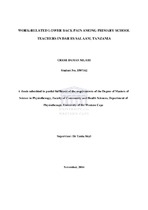| dc.description.abstract | Lower back pain (LBP) is one of the most common work-related health problems in economically developed countries and the most prevailing musculoskeletal condition that causes disability in the developing nations. School teachers are susceptible to LBP due to the nature of their daily work routine which is physically demanding and include common activities such as long hours of sitting, standing and bending that have been identified as risk factors for LBP. The aim of the study was to determine the role of work-related activities in the prevalence of LBP amongst primary school teachers in the Dar-es-Salaam region of Tanzania. To achieve this goal, the study sought to meet the following three objectives: to determine the prevalence of LBP among primary school teachers; to determine the work-related physical activities contributing to LBP among primary school teachers, and to determine and explore the application of kinetic handling principles in their daily work environment. The study was conducted in eighty randomly selected primary schools from the Temeke, Ilala and Kinondoni districts. A sequential explanatory mixed method approach was utilised. A cross-sectional descriptive design was employed. A self-administered questionnaire consisting of three sections (socio-demographic information; the Nordic Back Pain Questionnaire and the Oswestry Lower back pain Questionnaire) was completed by two hundred and eighty six primary school teachers with a mean age of 41.2 years (SD=9.9), 78.7% female and 21.3% male. Thirty primary school teachers participated in the participant observation of the application of kinetic handling principles in their daily work environment and focus group discussions. Results of the study found that 17.1% of the teachers had LBP during the past week while 82.9% experienced LBP during the past year. In addition, 30.8% of the teachers had referred pain, mostly to the thigh area (43.9%). Less than fifty percent (43.5%) of the participants had severe pain in sitting (76 – 100mm on the VAS scale) while 26.9% was not able to sit for more than an hour while teaching due to LBP. A significant relationship was found for severe functional disability and gender (p=0.032). The study demonstrated poor application of kinetic handling principles at work. Factors impeding teachers’ efforts to implement best practices and back care techniques in their daily teaching activities were work environment (poor facilities and equipment; heavy workload and staff shortage) and uncertainty about desired practice. In order to address the higher prevalence of lower back pain the study recommended, inter alia, improvement of the work environment for teachers by providing proper office furniture, re-assessment of education standards such as students /class ratio, students/desk ratio and number of teachers for schools and lastly, the implementation of health education and health promotion strategies to prevent LBP amongst primary school teachers. | en_US |

